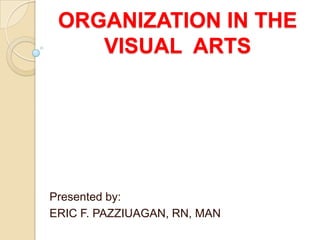
Organization in the visual arts
- 1. ORGANIZATION IN THE VISUAL ARTS Presented by: ERIC F. PAZZIUAGAN, RN, MAN
- 2. Harmony Essential to beauty. Visual arts: achieved by establishing a pleasing relationship between the various elements. Unity: various parts of the design will give an appearance of belonging together. Repetition of angles and curves, shapes, lines and colors will give a harmonious effect.
- 3. To relieve monotony, there must be variety. ◦ The spice of life and of art. ◦ May be achieved by the diversity of materials used and slight contrast in color, texture, shape and space arrangements. Painting and interior decoration: complementary hues when used will give contrast. Sculptor: use of conrast of texture, such as smooth and rough, in his work.
- 4. Architect: instead of using a long line of windows, may group the windows and introduce space between the groups. Monotony produced by vertical lines of columns in buildings may be relieved by transition lines. If the wall paper in room is figured, the use of plain curtains will make it more beautiful and restful. Artist must ne careful that the variety he introduces does not destroy the harmonious effect.
- 5. Balance All parts are equally distributed around a central point. Weights are equally distributed on each side of a center of fulcrum, as in see-saw. Gives a feeling of stability and rest. Makes an object or room not only interesting but also pleasant to look at.
- 6. Formal balance Symmetrical balance Achieved by making both sides exactly alike. Objects of the same size and shape, when arranged on two sides of a center, will produce formal balance. Gives an atmosphere of dignity and formality.
- 7. Informal or asymmetrical balance Occult balance More difficult to achieve the formal balance; however, the results are more interesting. Achieved when objects of unequal weights or unequal attractions are placed at the correct distances from the center as when a large object or an object of stronger attraction is placed near the center, while the smaller object or one with less striking attraction is moved
- 8. Generally used when we want to attract the attention of observers and set them thinking about the object under observation. ◦ Active balance: suggests spontaneity and movement. ◦ Gives an impression of casualness.
- 9. Proportion Determined by a comparison of the sizes of different parts of an object or of an arrangement. Achieved when one part of an object does not seem too big or too small for other parts. Painting: the principle of good proportion is useful in combining colors successfully and in determining the margins for mounting. ◦ There should be more of one color than the others.
- 10. Rhythm Achieved by the regular or harmonious recurrence of lines, forms, and colors. Organized movement, a beat, a repetition. Through the repetition of lines or forms, a pattern is produced, which the eye follows as it moves from the right to left. A series of units repeated one after
- 11. Through the use of color, charming patterns will be formed that will carry the eye from one part of a room to another. Repetition of color in different parts of the room produces a rhythmical effect which is not only charming but pleasing. Rhythmical patterns help the aye to move easily from one part of the room to another or from one part of a design to another.
- 12. It is used as the most effective way of creating aesthetic unity in prose, music, dance, painting, architec ture, and sculpture. Space arts: rhythm is used in repetition, alternation, and gradation of the elements of art, line, form, color and texture.
- 13. Emphasis/ Subordination Some parts easily catch our attention and interest while other parts are not noticed at all. Produced by the design or form that catches our attention while the rest are subordinated. Pattern emphasized usually forms the center of interest. Giving importance to the parts or to the whole.
